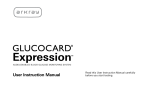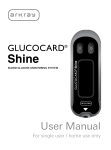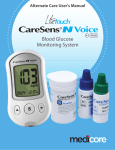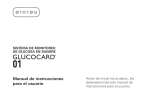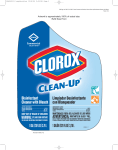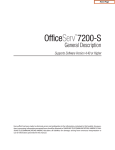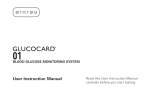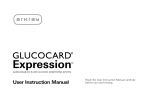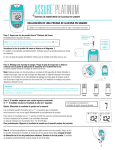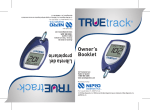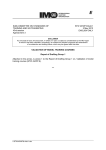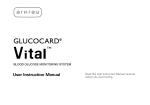Download Assure Prism multi QA/QC Manual
Transcript
Quality Assurance / Quality Control (QA/QC) Reference Manual Table of Contents Introduction Section A System Components Assure® Prism multi Blood Glucose Meter Meter Display Screen Assure® Prism multi Test Strips Assure® Prism Control Solution Meter Specifications Section B Meter Operation and Set-Up Meter Set-Up Performing a Blood Glucose Test Performing a Control Solution Test Meter Memory Inserting or Replacing the Batteries Cleaning and Disinfecting the Meter Troubleshooting Assure® Prism multi Test Strips Assure® Prism Control Solution Section C In-Service Training In-Service Guide Competency Checklist Self-Test Nurse In-Service Training Record Section D Quality Assurance/Quality Control Recording Forms Meter Tracking Quality Control Record Field Inspection Report Section E Regulatory Review and Guidelines for QA/QC Protocols Competency Checklist Accuracy and Precision Studies Alternative Sites Testing Evaluation Section F Addendums Product Ordering Warranty Introduction The Assure® Prism multi Blood Glucose Monitoring System is intended for the quantitative measurement of glucose in fresh capillary whole blood samples drawn from the fingertips and alternative sites such as the forearm, palm, thigh, and calf. Alternative site testing should be used only during steadystate blood glucose conditions. The system is intended for use outside the body (in vitro) and is intended for multiple-patient use in professional healthcare settings as an aid to monitor the effectiveness of diabetes control. The system is only used with the auto-disabling, single use lancing device. It is not intended for use on neonates and is not for the diagnosis or screening of diabetes. This comprehensive manual has been designed to provide you with a thorough reference source for the Assure® Prism multi System including: •Product operations •Training and in-services •Guidelines for policies and procedures •Quality Assurance and Quality Control (QA/QC) programs •Reviews of regulatory materials All of these materials have been designed to assist you in meeting the necessary requirements for various certification programs and agencies. We trust that this Quality Assurance/Quality Control manual will provide you with the needed support tools for your blood glucose monitoring program. If you have any questions after receiving the manual, please call ARKRAY’s Customer Service Department at 800.818.8877. SECTION A System Components ASSURE® PRISM MULTI BLOOD GLUCOSE METER Test Strip Port Insert test strip here Backlight Button Turns the backlight on/off Test Strip Ejector Display Shows results, messages Button Selects or changes information Button Selects or changes information Button Turns the meter on/off and confirms menu selections ORDERING DETAILS ARKRAY Product Code# 530001 NDC# 08317-5300-01 SECTION A METER DISPLAY SCREEN Appears when test results stored in the memory are displayed. Appears only when the sound is set to OFF. Appears when the time alarm has been set. Appears when the control solution test results are saved or displayed. Test results displaying panel. Indicates low battery. Appears when the temperature is displayed. Appears during post-meal testing and when post- meal test results are displayed. Date/ Temperature Time Indicates meter is ready for testing. Note: • It is recommended to check if the display screen on the meter matches the illustration above every time the meter turns on. Do not use the meter if the display screen does not exactly match the illustration as the meter may show incorrect results. • The unit of measurement for your Assure Prism multi Meter is preset and fixed in mg/dL. SECTION A ASSURE® PRISM MULTI TEST STRIPS The Assure® Prism multi Blood Glucose Monitoring System measures blood glucose quickly and accurately. It automatically absorbs the small blood sample applied to the narrow edge of the strip. Contact bars Gently push the test strip, with its contact bars facing up, into the test strip port of meter Confirmation window Check here to see whether sufficient blood sample has been applied Insert Edge to apply blood sample Apply blood sample here for testing SAFETY INSTRUCTIONS FOR USING TEST STRIPS • All components that come into contact with blood samples should be considered biohazards capable of transmitting viral diseases between patients and healthcare professionals. • Assure Prism multi Test Strips should be used only with fresh capillary whole blood samples. • Do not reuse test strips. • Do not use Assure Prism multi Test Strips beyond the expiration date. This may cause inaccurate results. • Test strips in new, unopened vials and test strips in vials that have been opened can be used up until the expiration date printed on the test strip box and vial label if the test strips are used and stored according to its storage and handling methods. • Store test strips in a cool and dry place at a temperature of 34-86˚F (1-30˚C). • Keep test strips away from direct sunlight or heat and do not freeze. • Store test strips only in their original vial. • Close the vial tightly after taking out a test strip and use the test strip immediately. • Handle test strips only with clean and dry hands. • Do not bend, cut, or alter test strips in any way. • For detailed storage and usage information, refer to the Assure Prism multi Test Strip package insert. • Keep the meter and testing supplies away from young children. • The test strip vial contains drying agents that are harmful if inhaled or swallowed and may cause skin or eye irritation. ORDERING DETAILS Assure® Prism multi Test Strips 50-count ARKRAY Product Code# 530050 NDC# 08317-5300-50 Assure® Prism multi Test Strips 100-count 530100 08317-5301-00 SECTION A ASSURE PRISM CONTROL SOLUTION ORDERING DETAILS Assure® Prism Control Solutions 1 & 2 ARKRAY Product Code# NDC# 530006 08317-5300-06 Assure® Prism Control Solution METER SPECIFICATIONS For additional information refer to the Assure® Prism multi User Manual. Product Specifications Test strips Measurement range Sample size Test time Sample type Calibration Assay method Battery life Power Memory Size Weight Assure® Prism multi Test Strips 20–600 mg/dL Minimum 0.5 µL 5 seconds Fresh capillary whole blood Plasma equivalent Electrochemical 1,000 tests Two 3.0 lithium batteries (disposable, type CR2032) 500 test results 93 X 56 X 21 mm(3.66 x 2.20 x 0.83 in.) 59.6 g(2.10 oz)(with batteries) Operating Ranges Temperature Relative humidity Hematocrit Altitude Unit of measurement 50°F–104°F (10°C–40°C) 10%–90% 20%–60% 10,000 ft. (3,048 meters) mg/dL SECTION B Meter Operation and Set-Up METER SET-UP You should check and update the meter-settings such as time and date before using your meter or after changing the meter batteries. Press and hold the button for 3 seconds to enter the SET mode. Whenever you want to complete the settings and exit from the SET mode, press and hold the button for 3 seconds again. Press or to reach the accurate value. Press and hold to scroll faster. Adjusting the Date and Time Step 1: Entering the SET Mode Press and hold the button for 3 seconds. After all the segments flash across the screen, SET will be displayed on the screen. Press the button again to progress to the next step. Step 2: Setting the Year Press or until the correct year appears. Press and hold button to scroll through the numbers quickly. After setting the year, press the button to confirm your selection and progress to the next step. Step 3: Setting the Month A number indicating the month will be blinking on the left corner of the screen. Press or until the correct month appears. Press the button to confirm your selection and progress to the next step. Step 4: Setting the Date Press or until the screen displays the correct date. Press the button to confirm the date and progress to the next step. Step 5: Setting the Time Format The meter can be set in the AM/PM 12-hour or the 24-hour clock format. Press or to select a format. The AM/PM is not displayed in the 24-hour format. After selecting the format, press the button to progress to the next step. Step 6: Setting the Hour Press or until the correct hour appears. After the hour is set, press the button to progress to the next step. Step 7: Setting the Minute Press or until the correct minute appears. After setting the minute, press the button to progress to the next step. SECTION B Step 8: Setting the Sound On/OFF On pressing or , the screen will display On or OFF. Press the button to confirm the selection. The meter will beep in the following instances if set to On. • When you press the button and/or meter or to set the alarm. button to turn on the • When the test strip is inserted in the meter. • When the blood or control solution sample is absorbed into the test strip and the test starts. • When the test result is displayed. If the sound is set to OFF, none of the sound functions will work. Note: • symbol is displayed only when the sound is set to OFF. • At any stage, press the button for 3 seconds to exit SET mode and turn off the meter. Press and hold button to quickly scroll through the numbers. Note: We do not recommend using the memory feature including post meal alarms, pre-set blood glucose or averaging in a multi-patient setting. Results stored in the memory are not related to a specific patient. SECTION B PERFORMING A BLOOD GLUCOSE TEST Caution: To reduce the chance of infection Before performing a blood glucose test, observe the following safety precautions: • All components that come into contact with blood samples should be considered to be biohazards capable of transmitting viral diseases between patients and healthcare professionals. • A new pair of clean gloves should be worn by the user before testing each patient. • Wash hands thoroughly with soap and water before putting on a new pair of gloves and performing the next patient test. • Use only an auto-disabling, single-use lancing device for each patient. • The meter should be cleaned and disinfected after use on each patient. For more information, please refer to the following guidelines: Preparing the Lancing Device 1. “Biosafety in Microbiological and Biomedical Laboratories(BMBL)”, http://www.cdc.gov/biosafety/ publications/bmbl5/ 2. “Protection of Laboratory Workers From Occupationally Acquired Infections; Approved Guideline-Third Edition” Clinical and Laboratory Standards Institute (CLSI) M29-A3. You will need a lancing device in order to collect a blood sample. Only an auto-disabling, single use lancing device should be used. The auto-disabling, single use lancing device can be purchased from your medical distributor or by telephone from the manufacturer. Please read the instructions provided by the lancing device manufacturer before using it. Step 1 Wash hands and the sample site with soap and warm water. Rinse and dry thoroughly. Wear appropriate protective gears such as disposable gloves. Preparing the Meter and Test Strip Step 2 Insert a test strip with the contact bars facing up into the meter’s test strip port. Push the strip gently into the strip port until the meter automatically turns on and the symbol appears. SECTION B Applying the Blood Sample Step 3 Obtain a blood sample using a lancing device. Place the lancing device against the sampling site in the direction of the arrow. The best puncture sites are areas on the middle or ring fingers. Remove the device from the finger. Wait a few seconds for a blood drop to form. A minimum volume of 0.5 microliter is needed to fill the confirmation window. Step 4 After the symbol appears on the screen, apply the blood sample to the narrow end of the test strip until the meter beeps. If the confirmation window is not filled in time because of abnormal viscosity or insufficient volume, an Er4 message may appear. Approximate size It is recommended that the application of the blood sample to the test strip be performed virtually vertical to the sample site as shown in the diagram. Note: The meter will switch off if the blood sample is not applied within 2 minutes of the symbol appearing on the screen. If the meter turns off, remove the strip, reinsert it, and start from Step 2. Step 5 The test result will appear after the meter counts down from 5 to 1. The result will be automatically stored in the meter’s memory. Step 6 Slide the ejector button on the right side of the meter to discard used test strips safely in a disposable container. If the test strip is removed, the meter will automatically turn off after 3 seconds. Turning On the Backlight When the meter is on, pressing the backlight button powers on the display backlight. The backlight will turn off after 15 seconds or when you press the backlight button again. Good Sample Insufficient Sample SECTION B PERFORMING A CONTROL SOLUTION TEST You should check your meter and test strips using Assure® Prism Control Solutions (Control 1 and 2). Assure® Prism Control Solutions contain known amounts of glucose and are used to check that the meter and the test strips are working properly. The test strip vials have Assure® Prism Control Solution ranges printed on their labels. Compare the result displayed on the meter to the Assure® Prism Control Solution range printed on the test strip vial. Before using a new meter or a new vial of test strips, you should conduct a control solution test following the procedure with two different levels of solutions (Control 1 and 2). Note: • Use Assure® Prism Control Solutions only. • Check the expiration dates printed on the bottle. When you first open a control solution bottle, record the discard date (date opened plus three (3) months) in the space provided on the label. • Make sure your meter, test strips and control solutions are at room temperature before testing. Control solution tests must be done at room temperature 68-77˚F (20-25˚C). • Before using the control solution, shake the bottle, discard the first 1 or 2 drops and wipe the top of the control solution cap clean. • Close the control solution bottle tightly and store at a temperature of 46-86˚F (8-30˚C). You should do a control solution test: • When you want to practice the test procedure using the control solution instead of blood • When using the meter for the first time • Whenever you open a new vial of test strips • If the meter or test strips do not function properly • If your symptoms are inconsistent with the blood glucose test results and you feel that the meter or test strips are not working properly • If you drop or damage the meter Assure® Prism Control Solution Testing Step 1 Insert a test strip into the meter’s test strip port, with the contact bars facing upwards. Gently push the test strip into the test strip port until the meter beeps. Be careful not to bend the strip while pushing it in. The symbol will be displayed on the screen. SECTION B Step 2 Shake the Assure® Prism Control Solution bottle well before each test. Step 3 Remove the cap and squeeze the bottle to discard the first 1 or 2 drops. Apply one drop of control solution to the top of the control solution cap. Step 4 After the symbol appears on the display, apply the solution to the narrow edge of the test strip until the meter beeps. Make sure the confirmation window fills completely. Note: The meter will switch off if the control solution sample is not applied within 2 minutes of the symbol appearing on the screen. If the meter turns off, remove the strip, reinsert, and start from step 2. Step 5 A test result will appear after the meter counts down from 5 to 1. After your control solution result appears on the display, press until “check” appears on the display. for 3 seconds When “check” is displayed, the result is stored in the meter’s memory but it is not included in the averages. Compare the result displayed on the meter to the range printed on the test strip vial. If the result falls within the specified range, you are ready to use the meter and test strips to test your blood. Control Solution Range Control 1: Control 2: Step 6 Remove the used test strip from the meters test strip port. The meter will turn off automatically. Used strips should be discarded safely in disposable containers. Caution: The ranges printed on the test strip vial are for Assure® Prism Control Solutions only. They do not have any connection to your blood glucose level. Note: Assure® Prism Control Solution can be purchased from your local supplier or pharmacy. If they do not stock it, contact ARKRAY Customer Service: 800.818.8877, 24 hours a day, 7 days a week, USA and Canada. Comparing the Control Solution Test Results The test result of each control solution test should be within the range printed on the label of the test strip vial. Repeat the control solution test if the test result falls outside of this range. Out of range results may occur due to the following factors: Situations Actions • When the control solution bottle was not shaken well • When the meter, test strip, or the control solution were exposed to high or low temperatures • When the first drop of the control solution was not discarded or the top of the cap was not wiped clean • When the meter is not functioning properly Repeat the control solution test • When the control solution is past the expiration date printed on the bottle • When the control solution is past its discard date (the date the bottle was opened plus three (3) months) • When the control solution is contaminated Discard the used control solution and repeat the test using a new bottle of control solution If results continue to fall outside the range printed on the test strip vial, the test strip and meter may not be working properly. Do not use your system and contact Customer Service: 800.818.8877, 24 hours a day, 7 days a week, USA and Canada. SECTION B METER MEMORY The Assure Prism multi Meter can save up to 500 test results with time, date and temperature. If the memory is full, the oldest test result will be deleted and the latest test result will be stored. Note: We do not recommend using the memory feature including post meal alarms, pre-set blood glucose or averaging in a multi-patient setting. Results stored in the memory are not related to a specific patient. Viewing Test Results Step 1 Press the or button to turn the meter on. The current date and time will be displayed on the bottom of the screen followed by the 1 day average value and the number of the test results saved within the current day. The number of tests within the current day Step 2 Use the button to scroll through the test results, starting from the most recent and ending with the oldest. The test date and the recorded temperature will display alternately. Press the button button to return to the results seen previously. After checking the stored test result, press the button to turn off the meter. Note: The control solution test results saved with “check”symbol will be displayed with “check” symbol when you review the stored test results. INSERTING OR REPLACING THE BATTERIES The Assure® Prism multi Meter uses two 3.0 V lithium batteries. Before using the meter, check the battery compartment and insert batteries if empty. When the symbol appears on the display while the meter is in use, the batteries should be replaced as soon as possible. The test results may not be saved if the batteries run out. Step 1 Make sure the meter is turned off. Push the cover in the direction of the arrow to open the battery compartment. Step 2 To remove the used batteries, place your finger under each battery and pull upward. Insert two new batteries with the + side facing up and make sure the batteries are inserted firmly. Step 3 Slide the cover back on the battery compartment. Push down until you hear the tab click into place. Note: Removing the meter batteries will not affect your stored results. However, you may need to reset your meter settings. SECTION B CLEANING AND DISINFECTING THE METER To minimize the risk of transmission of blood-borne pathogens, the cleaning and disinfection procedure should be performed as recommended in the instructions below. The meter should be cleaned and disinfected after use on each patient. This Blood Glucose Monitoring System may only be used for testing multiple patients when Standard Precautions and the manufacturer’s disinfection procedures are followed. Cleaning and Disinfection The cleaning procedure is needed to clean dirt as well as blood and other body fluids on the exterior of the meter before performing the disinfection procedure. The disinfection procedure is needed to prevent transmission of blood-borne pathogens. Clorox Germicidal Wipes with 0.55% sodium hypochlorite as the active ingredient have been tested and approved for cleaning and disinfecting the Assure Prism multi Meter. This disinfectant has been shown to be safe for use with this meter. Please read the instructions for use from the manufacturer of Clorox Germicidal Wipes before use. Name Clorox® Germicidal Wipes Manufacturer Clorox Professional Products Company 1.800.537.1415 www.cloroxprofessional.com EPA Registration Number 67619-12 Active Ingredients 0.55% Sodium Hypochlorite • Any disinfectant product with the EPA registration number of 67619-12 may be used on this device. • A list of Environmental Protection Agency (EPA) registered disinfectants effective against HIV, Hepatitis B, and C virus can be found at the following website: http://www.epa.gov/ oppad001/list_d_hepatitisbhiv.pdf Go to http://www.assureusa.com/cleandisinfect for the most up-to-date information on approved cleaning and disinfecting procedures and materials for ARKRAY blood glucose meters. If you have any questions, please contact our Technical Customer Service department at 800.818.8877. SECTION B Cleaning and Disinfecting procedures Note: Do not get fluids inside the meter through the test strip port, data port or battery compartment. Never immerse the meter or hold it under running water because it will damage the meter. Cleaning Step 1 Wear appropriate protective gear such as disposable gloves. Step 2 Open the cap of the Clorox Germicidal Wipes container and pull out 1 towelette and close the cap. Step 3 Wipe the entire surface of the meter 3 times horizontally and 3 times vertically using one towelette to clean blood and other body fluids. Assure® Prism Multi Blood Glucose Meter • For multiple patients / professional use. • Use with Assure Prism Multi Blood Glucose Test Strip. • For testing outside of the body (in vitro diagnostic use only). • Model: GM505RA 3V, 11 mA (CR2032 X 2) Manufactured for Minneapolis, MN 55439 USA 800.566.8558 www.arkrayusa.com Made in Korea Front Contact Customer Service at 800.566.8558, 24 hours a day, 7 days a week, USA and Canada. P/N 5117-00 REV 07/14 Back Both sides Step 4 Dispose of the used towelette in a trash bin. The meter should be cleaned prior to disinfection. Disinfecting Step 5 P ull out 1 new towelette and wipe the entire surface of the meter 3 times horizontally and 3 times vertically using a new towelette to remove blood-borne pathogens. Step 6 Dispose of the used towelette in a trash bin. Step 7 A llow exteriors to remain wet for 1 minute, then wipe the meter using a dry cloth. dry cloth 1minute Step 8 A fter disinfection, the user’s gloves should be removed to be thrown away and hands washed before proceeding to the next patient. Prior to Re-Use 1minute If any of the following deterioration signs appears after cleaning or disinfecting, please stop using the system and contact Customer Service: 800.818.8877, 24 hours a day, 7 days a week, USA and Canada. • When the inscriptions on the exterior of the meter have been removed • When the color of the meter has changed or faded • When cracks or roughness develop on the meter • When a part of the segment on the meter display does not flash • When control solution test results do not fall within the stated range on the test strip vial More information is available at: http://www.cms.gov/Regulations-and-Guidance/Guidance/Transmittals/index.html http://www.cdc.gov/injectionsafety/blood-glucose-monitoring.html www.fda.gov/MedicalDevices/Safety/AlertsandNotices/ucm224025.htm http://www.cdc.gov/injectionsafety/Fingerstick-DevicesBGM.html SECTION B TROUBLESHOOTING Display Screen Messages Please first read this section. If you still have questions, call Customer Service at 800.818.8877, (24 hours a day, 7 days a week, USA and Canada only). If outside the USA and Canada, contact your local ARKRAY distributor. Contact your healthcare professional if you c annot reach Customer Service. Do not send your meter to ARKRAY or your local dealer without first calling to get approval to do so. HI and Lo Messages HI Message The meter displays results between 20-600 mg/dL. “HI” appears when the blood glucose level is greater than 600 mg/dL and indicates severe hyperglycemia (much higher than normal glucose levels). If “HI” is displayed again upon retesting, please contact the patient’s healthcare provider immediately. Lo Message “Lo” appears when a test result is less than 20 mg/dL and indicates severe hypoglycemia (very low glucose levels). If “Lo” is displayed again upon retesting, please contact the patient’s healthcare provider immediately. Note: If messages for hyperglycemia or hypoglycemia are displayed even if the patient does not have those conditions, please contact Customer Service: 800.818.8877, 24 hours a day, 7 days a week, USA and Canada. Error Messages A used test strip was inserted. Repeat the test with a new test strip. The blood or control solution sample was applied before the symbol appeared. Repeat the test with a new test strip and wait until the before applying the blood or control solution sample. symbol appears The blood sample has abnormally high viscosity or insufficient volume. Repeat the test with a new test strip. This error message may appear when the wrong blood glucose test strip is used instead of an Assure® Prism multi blood glucose test strip. Repeat the test with an Assure Prism multi test strip. There is a problem with the meter. Do not use the meter. Contact Customer Service: 800.818.8877, 24 hours a day, 7 days a week, USA and Canada. SECTION B The temperature during the test was above the operating range. Move to an area where the temperature is within the operating range (50-104˚F/10-40˚C) and repeat the test after the meter and test strips have reached a temperature within the operating range. The temperature during the test was below the operating range. Move to an area where the temperature is within the operating range (50-104˚F/10-40˚C) and repeat the test after the meter and test strips have reached a temperature within the operating range. Note: If the error messages persist, please contact Customer Service: 800.818.8877, 24 hours a day, 7 days a week, USA and Canada. General Troubleshooting Problem The display is blank even after inserting a test strip. Troubleshooting • Check whether the test strip is inserted with the contact bars facing up. • Check if the strip has been inserted completely into the test strip port. • Check if the appropriate test strip was used. • Check if the batteries are inserted with the “+” side facing up. • Replace the batteries. The test does not start even after applying the blood sample on the strip. • Check if the confirmation window is filled completely. The test result does not match the way you feel. • Repeat the test after inserting a new test strip. • Repeat the test after inserting a new test strip. • Check the expiration date of the test strip. • Perform control solution test. Note: If the problem is not resolved, please contact Customer Service: 800.818.8877, 24 hours a day, 7 days a week, USA and Canada. AlertsandNotices/ucm224025.htm) or at CDC Clinical Reminder(http://www.cdc.gov/injectionsafety/FingerstickDevicesBGM.html). • All components that come into contact with blood samples should be considered to be biohazards capable of transmitting viral diseases between patients and healthcare professionals. • Only auto-disabling, single use lancing device should be used for each patient. • The meter should be disinfected after use on each patient. This BGMS may only be used for testing multiple patients when Standard Precautions and the pre-cleaning and disinfection procedures as recommended in the User's Manual that came with your system are followed. • Y ou can get more safety information at FDA Public Health Notification (http://www. fda.gov/MedicalDevices/Safety/ CAUTION : To reduce the chance of infection •Alternative site and fingertip results may differ significantly due to rapid changes in the glucose level after meals or exercise, hypoglycemic symptoms, or effects of drugs such as insulin. Use a fingertip sample if you suffer from hypoglycemia or have experienced hypoglycemic shock or symptoms. •AST results should never be used to calibrate Continuous Glucose Monitoring Systems nor entered into an insulin dosing calculator or pump for dosing recommendations. •For instructions on how to obtain samples from alternative sites, please refer to the AST section of the User's manual for your meter. CAUTION Select a clean, soft and fleshy sample site free of visible veins and hair and away from bones. Gently massage the sample site to increase blood circulation to minimize differences between fingertip and alternative site test results. Place auto-disabling, single-use lancing device against the sample site. Press the release button. Massage the site to obtain a round drop (at least 0.5 μL) of blood. Apply test strip tip to blood sample. Alternative Site Blood Sampling (forearm, palm, thigh, calf) Place auto-disabling, single-use lancing device against the side of your fingertip. Press the release button. Massage the fingertip to obtain a round drop (at least 0.5 μL) of blood. Apply test strip tip to blood sample. Fingertip Site Blood Sampling Wash hands and sample site with soap and warm water. Rinse and dry thoroughly before collecting the blood sample with a lancing device. Wear appropriate protective gears such as disposable gloves. BLOOD SAMPLE COLLECTION PROCEDURE (24 hours a day, 7 days a week, USA and Canada). • Keep test strips and the test strip vial away from children. The test strips and vial cap may be choking hazards. Drying agents in the vial cap may be harmful if inhaled or swallowed or may cause skin or eye irritation. • Test strips are for single use only. Do not reuse. • If the test strip does not absorb the blood sample properly, please contact Customer Service at 800.818.8877 WARNINGS AND PRECAUTIONS • Store unused test strips only in their original vial. • Store vial in a cool and dry place between 34-86˚F (1-30˚C). • Keep the vial away from direct sunlight and heat. • Do not freeze test strips or vial. • Close vial cap tightly immediately after taking out a test strip. • Use the test strip immediately after taking it out of the vial. • Handle test strips only with clean, dry hands. • Do not bend, cut, or alter the test strips in any way. • Do not force a test strip into the meter. Gently push it into the meter's test strip port. • Apply only fresh capillary whole blood to the test strip. •U se all of the test strips within the expiration date printed on the test strip box and vial label. • Do not use the expired test strips and dispose the expired test strips immediately because using test strips past their expiration dates can produce incorrect test results. • Test strips in new, unopened vials and test strips in vials that have been opened can be used until the expiration date printed on the test strip box and vial label if the test strips are used and stored according to its storage and handling methods. STORAGE AND HANDLING The glucose in the blood sample mixes with special chemicals on the test strip to produce a small electrical current. The meter converts this electrical current to glucose concentration. TEST PRINCIPLE The Assure Prism multi Blood Glucose Test Strips are for use with the Assure Prism multi Blood Glucose Meter to quantitatively measure glucose in fresh capillary whole blood samples drawn from the fingertips and alternative sites such as the forearm, palm, thigh, and calf. Alternative site testing should be used only during steady-state blood glucose conditions. The Assure Prism multi Blood Glucose Monitoring System is intended for use outside the body (in vitro) and is intended for multiple-patient use in professional healthcare settings as an aid to monitor the effectiveness of diabetes control. The system is only used with auto-disabling, single use lancing device. It is not intended for use on neonates and are not for the diagnosis or screening of diabetes. INTENDED USE Please read this information and the User's Manual of your meter before using the Assure® Prism multi Test Strips. IMPORTANT Each Assure Prism multi Test Strip contains the following reagents: Glucose oxidase (Aspergillus sp.): 2.7 units Hexaamineruthenium(III) chloride: 45.7 μg Other ingredients: 1.6 μg CHEMICAL COMPOSITION The Assure Prism Control Solutions (Control 1 and 2) contain fixed amounts of glucose and are used for checking whether the test strips and the meter are working together properly. Run a check when you: • Want to practice the test procedure using the control solution instead of blood. • Use the meter for the first time. • Open a new vial of test strips. • Have symptoms that are inconsistent with your blood glucose test results. • Believe your test results are not accurate. • Suspect your meter and test strips are not performing properly. • Drop or damage the meter. If your control solution test results do not fall within the range printed on the test strip vial, repeat the test. Out of range results may be due to one or more of the following factors: • Error in performing the test. • Expired or contaminated control solution. • Expired or damaged test strip. • Failure to shake the control solution bottle. • Failure to discard the first drop of control solution and wipe the top of the bottle cap clean. If results continue to fall outside the range printed on the vial, the Assure Prism multi test strips and the meter may not be working properly. If so, do not use your system and contact Customer Service at 800.818.8877 (24 hours a day, 7 days a week, USA and Canada). METER AND TEST STRIP PERFORMANCE CHECK • An abnormally high or low red blood cell count (hematocrit level over 60% or below 20%) may produce inaccurate results. • Inaccurate results may occur in severely hypotensive (having low blood pressure) individuals or patients in shock. Inaccurate low results may occur for individuals experiencing a hyperglycemic-hyperosmolar state, with or without ketosis. Critically ill patients should not be tested with blood glucose meters. • Severe dehydration (excessive water loss) may cause falsely low results. If you believe you are suffering from severe dehydration, consult your physician immediately. • There is no effect from altitudes of up to 10,000 ft (3,000 m) above sea level. • Interferences: Acetaminophene, ascorbic acid (vitamin C), uric acid and other reducing substances (when occurring in normal blood or normal therapeutic concentrations) do not significantly affect results. However, abnormally high concentrations in blood may cause inaccurate high results. • Blood samples that contain a high concentration of dissolved oxygen may lower the test result. • Discard used test strips properly in a container for sharp objects. Please note that: Low or high blood glucose readings can indicate a potentially serious medical condition. If your results are unusually high or low, or do not match the way you feel, repeat the test with a new test strip. If your reading is inconsistent with your symptoms or your result is less than 60 mg/dL or higher than 240 mg/dL, contact the patient's healthcare provider. Unexpected Results If the test result is above 600 mg/dL, HI will appear on the display, showing extreme hyperglycemia (much higher than normal blood glucose). Wash and dry your hands thoroughly, then repeat the test with a new test strip. If the result repeats, contact the patient's healthcare provider immediately for advice and treatment. Extremely High Blood Glucose Results If the test result is below 20 mg/dL, Lo will appear on the display, showing extreme hypoglycemia (dangerously low blood glucose). Wash and dry your hands thoroughly, then repeat the test with a new test strip. If the result repeats, contact the patient's healthcare provider immediately for advice and treatment. Extremely Low Blood Glucose Results The range of a normal fasting* blood glucose level for non-diabetic adults is between 70 and 99 mg/dL. Two(2) hours after a meal, the range of a normal blood glucose level for non-diabetic adults is between 100 and 139 mg/dL.1 *Fasting is defined as no caloric intake for at least eight(8) hours. Normal Blood Glucose Results The Assure Prism multi Blood Glucose Meter will display results between 20 and 600 mg/dL. TEST RESULTS 1) Wash hands and sample site with soap and warm water. Rinse and dry thoroughly. Wear appropriate protective gears such as disposable gloves. 2) Insert the test strip into the meter’s test strip port with the contact bars facing up. Push the strip in gently into the strip port until the power automatically turns on. 3) The symbol will appear. 4) Use a lancing device to get blood sample. The sample must be at least 0.5 µL to fill the test strip reaction cell. When the symbol appears on the display, apply the blood sample to the edge of the narrow end of the test strip until the meter beeps. If the confirmation window is not filled completely, an “Er4” message will appear. 5) Meter will count down from 5 to 1 on the display. The test result, time, and date will appear and automatically store in the meter memory. Remove the used test strip from the test strip port. The meter will turn off after 3 seconds. TEST PROCEDURE Assure® Prism multi Blood Glucose Test Strips 1.017 -7.39 mg/dL 0.992 122 40-577 mg/dL Within ± 5 mg/dL 11/11(100%) Within ± 10 mg/dL 11/11(100%) Within ± 5% 47/111(42%) Within ± 10% 89/111(80%) Within ± 15% 109/111(98%) Within ± 5 mg/dL 2/2 (100%) 2/2 (100%) 1/2 (50.0%) 1/2 (50.0%) 1/2 (50.0%) Within ± 10 mg/dL 2/2 (100%) 2/2 (100%) 2/2 (100%) 2/2 (100%) 2/2 (100%) Within ± 5% 34/56 (60.7%) 32/56 (57.1%) 31/56 (55.4%) 27/56 (48.2%) 24/56 (42.9%) Within ± 10% 51/56 (91.1%) 52/56 (92.9%) 52/56 (92.9%) 44/56 (78.6%) 43/56 (76.8%) Minneapolis, MN 55439 USA www.arkrayusa.com Manufactured for: © 2014 ARKRAY USA, Inc. P/N 5111-02 PGK7E0024 REV0 12/2014 In case of emergency, consult the patient's healthcare provider or emergency medical response. For questions / comments, contact Customer Service at 800.818.8877, 24 hours a day, 7 days a week, USA and Canada. 1. American Diabetes Association. “Standards of Medical Care in Diabetes – 2012.” Diabetes Care. January 2012; 35(1):S11-S63. Reference SD = 1.3 mg/dL CV = 2.3% CV = 2.4% SD = 1.8 mg/dL SD = 2.8 mg/dL CV = 2.6% CV = 3.1% CV = 2.7% Within ± 20% 56/56 (100%) 56/56 (100%) 56/56 (100%) 56/56 (100%) 56/56 (100%) Within ± 15 mg/dL 2/2 (100%) 2/2 (100%) 2/2 (100%) 2/2 (100%) 2/2 (100%) Within ± 15% 55/56 (98.2%) 56/56 (100%) 54/56 (96.4%) 54/56 (96.4%) 53/56 (94.6%) Total Precision Control avg. 36.2 mg/dL Control avg. 117.0 mg/dL Control avg. 321.8 mg/dL This study shows that there could be variation of up to 3.5%. Precision studies were performed in a laboratory. Within Run Precision Blood avg. 41.4 mg/dL Blood avg. 79.6 mg/dL Blood avg. 129.8 mg/dL Blood avg. 201.9 mg/dL Blood avg. 349.6 mg/dL Precision Calf Fingertip Forearm Palm Thigh Alternative site test results for glucose concentration ≥ 75 mg/dL Fingertip Forearm Palm Thigh Calf • Comparison of various AST with respect to the results of YSI measurements: Alternative site test results for glucose concentration < 75 mg/dL Alternative Site Testing Evaluation Within ± 20% 111/111(100%) Within ± 15 mg/dL 11/11(100%) 1.022 -8.31 mg/dL 0.992 118 58-577 mg/dL Obtained by lay users This study shows that the system compares well with a laboratory method. Accuracy results for glucose concentration ≥ 75 mg/dL Accuracy results for glucose concentration < 75 mg/dL Slope y-intercept Correlation coefficient (r) Number of sample Range tested Obtained by healthcare professionals The Assure Prism multi BGM System is calibrated to yield results equivalent to plasma glucose concentrations. The accuracy of the system was assessed by comparing blood glucose results obtained by patients with those obtained using a YSI Model 2300 Glucose Analyzer, a laboratory instrument. The results below were obtained by diabetic patients at clinic centers. Accuracy The measurement range of the Assure Prism multi Blood Glucose Monitoring System is 20 to 600 mg/dL. Measurement Range The performance of the Assure Prism multi Blood Glucose Test Strips has been evaluated in laboratory and clinical tests. PERFORMANCE CHARACTERISTICS Assure® Prism Control Solution IMPORTANT lease read the following information and the User’s Manual for P your meter before using the Assure® Prism Control Solution. INTENDED USE The Assure Prism Control Solutions are red in color. The Assure Prism Control Solutions are for use with the Assure Prism multi meters and test strips to check that the meter and the test strips are working together properly and that you are performing the test correctly. SUMMARY AND EXPLANATION The Assure Prism Control Solutions (Control 1 and 2) each contain a specific amount of glucose that is used to test the meter and test strips in the Assure Prism multi brand. The Assure Prism Control Solution is for self-testing outside the body (in vitro diagnostic use). This control solution may be used to check the performance of your meter and test strip or your testing technique. The test results you obtain should fall within the control solution range printed on the vial of test strips that you are using. CAUTION The control solution ranges printed on the test strip vial are for the Assure Prism Control Solution only. These ranges are used to check the meter and test strip performance. These are not recommended ranges for your blood glucose level. Use Assure Prism Control Solution when: • You want to practice the test procedure, without using blood. • You use your Assure Prism multi brand meter for the first time. • You begin using a new vial of test strips. • You suspect that your meter or the test strips are not working properly. • You think your test results are inaccurate or they do not reflect how you feel. • You drop your meter. STORAGE AND HANDLING Store the Assure Prism Control Solution at temperatures between 46-86˚F/8-30˚C, tightly capped in the vial. It must be kept at room temperature (68-77˚F/20-25˚C) at least 30 minutes before testing to obtain correct results. Do not refrigerate or freeze the control solution. WARNING AND PRECAUTIONS • The Assure Prism Control Solution is for in vitro diagnostic use only. • Use Assure Prism Control Solution only with your Assure Prism multi brand meter and its corresponding test strips. • Do not swallow or inject the control solution. • Check the expiration date shown on the vial label. Do not use if expired. • Do not use beyond 3 months (90 days) after opening the vial. Record the discard date (3 months from the day the vial was opened) on the vial label. • If the control test results are outside the range printed on the test strip vial, do not use your system to test blood until you have resolved the problem. • Control Solution, meter and test strips must be stored at room temperature (68-77˚F/20-25˚C) at least 30 minutes before testing. • This control solution contains a dye that may stain clothes. TEST PROCEDURE Step 1 Insert the test strip into the meter’s port. The applied blood symbol will appear on the display after 3 seconds. Step 2 Shake the control solution vial well before using. Step 3 Discard one or two drops of control solution. Apply one drop of control solution to the top of the control solution cap. Step 4 Touch the narrow edge of the test strip to the control solution until the meter beeps. Step 5 Test results appear after the meter counts down to 1. Compare your control result with the appropriate control solution range printed on the test strip vial. If the result falls within the specified range, you are ready to use the meter and the test strips to test your blood. Step 6 Remove the used test strip from the meter’s test strip port. The meter will turn off automatically. Please read your User’s Manual for further information before using the Assure Prism Control Solution. INTERPRETATION OF OUT OF RANGE RESULTS If your control solution test results do not fall within the expected range printed on the test strip vial, repeat the test. Out-of-range results may be due to one or more of the following factors: • An error in the way you perform the test. • Expired or contaminated control solution. • Damaged or outdated test strips. • A problem with the meter. • Control solution is too warm or too cold. • Failure to shake the control solution vial vigorously or to wipe the top of cap clean. IMPORTANT If your control solution test results continue to fall outside the range printed on the test strip vial, the system may not be working properly. Do not use the system. If you are unable to resolve the problem, contact Customer Service (800.818.8877). CHEMICAL COMPOSITION Each 4 mL vial of Assure Prism Control Solution contains: • D-Glucose • Preservative • FD&C red dye For questions / comments, contact Customer Service at 800.818.8877, 24 hours a day, 7 days a week, USA and Canada. In case of emergency, consult the patient's healthcare provider or emergency medical response. Manufactured for Minneapolis, MN 55439 USA www.arkrayusa.com © 2014 ARKRAY USA, Inc. P/N 5122-02 PGK7E0006 REV 12/14 SECTION C IN-SERVICE TRAINING Name of facility: IN-SERVICE GUIDE ASSURE® PRISM MULTI BLOOD GLUCOSE MONITORING SYSTEM: IN-SERVICE TRAINING AND CERTIFICATION Certified Instructor: Before signing checklist, the trainee must meet objectives listed below. 1. F amiliarization with components of the Assure® Prism multi Blood Glucose Monitoring System: Meter: Test Strips: eatures (strip release F button, test strip port, etc.) Serial Number Storage Cleaning and Disinfecting Toll-free Customer Service Number Lot Number Expiration Date Storage Control Solution Range Proper Strip Insertion Handling Control Solutions: Expiration Date Acceptable Range Test Procedure Safety Lancets: Usage / Activation Disposal 2. Describe/Demonstrate: Initial Meter Set-Up Options: Audible Beep Time Format Date Format Backlight Setting Instructor Name (Print) Operator Certified Yes Date Operator-Trainee Name (Signature) Instructor Name (Signature) Operator-Trainee Name (Print) No Next In-Service (Month/Year) Date Due: SECTION C Name of facility: COMPETENCY CHECKLIST ASSURE PRISM® MULTI BLOOD GLUCOSE MONITORING SYSTEM Certified Operator Date Certified Trainer The Certified Trainer should observe the Operator performing the following tasks: 1. Select and prepare the fingerstick site correctly. YES NO 2. Use lancet/lancing device correctly. YES NO 3. Insert test strip into meter correctly. YES NO 4. Apply blood to sample application tip correctly. YES NO 5. Dispose of lancet correctly. YES NO 6. Identify when to repeat test or check result with a laboratory test. YES NO 7. Record result correctly. YES NO 8. Follow facility protocol for quality control testing. YES NO 9. Clean/disinfect meter correctly. YES NO 10. Change battery. YES NO Did the Operator perform each task correctly? YES NO If yes, the Operator is now certified to use the Assure® Prism multi Blood Glucose Monitoring System. If no, retrain and perform tasks again. SECTION C Name of facility: SELF-TEST ASSURE® PRISM MULTI BLOOD GLUCOSE MONITORING SYSTEM The following is a multiple choice self-test that is designed to test your proficiency in using the Assure® Prism multi Meter. Answer the questions by circling the letter of the statement that is CORRECT. Check your answers against the correct answers, which are located at the end of the test. More than one answer may be acceptable on some questions. If you respond incorrectly to any of the questions, make sure you study the section or talk to your certified instructor. 1. The Assure® Prism multi Meter stores up to a. 200 b. 50 c. 500 d. 10 tests in memory. 2. The Assure® Prism multi Test Strips a. May be reused b. Can be used with other meters besides the Assure® Prism multi c Are sensitive to light, moisture, and humidity d. Has a confirmation window used to determine if a sufficient amount of blood sample has been applied 3. When obtaining a blood sample a. You should not wash the patient’s hand b. Hang the patient’s arm down below their heart for 10 to 15 seconds to increase blood flow c. You should lance the side of fingertip d. You should use the same site selection of the fingertip each time 4. When performing a test with control solutions a. Any brand of control solutions may be used b. The test strip must be in the meter before solutions are applied c. A clean tissue or cloth may be used to wipe the first 1 or 2 drops of control solution from the tip of the cap d. Compare the result displayed on the meter to the range printed on the test strip vial SECTION C 5. Assure Prism Control Solutions a. Are used for cleaning the meter b. Are used to verify that the test strips are reacting properly c. Are good for 90 days after opening d. Should not be used if strips have been exposed to extremes in temperature, light, or humidity 6. When applying blood to the Assure® Prism multi Test Strips a. Smear the blood sample b. Apply it to the narrow end of the test strip until the meter beeps c. The test result will appear after the meter counts down from 5 to 1 d. If meter does not start after adding the first blood drop, you may apply a second drop. 7. The Assure® Prism multi can be used with a. Whole blood b. Serum or plasma c. Neonatal blood samples d. Venous blood 8.The Assure® Prism multi should be cleaned and disinfected between patient tests to avoid cross-contamination? True False 9. Nurses who use the Assure® Prism multi meter to test patients should a. Wear gloves when cleaning the meter b. Test the meter with two control solutions c. Not rely on the memory or average features as they are not related to a specific patient d. Use a safety lancet, such as the Assure® Lance, to obtain a patient’s blood sample 10.The Assure® Prism multi meter uses four 3.0V lithium batteries True Name: Date: Score: False SECTION C SELF-TEST ASSURE® PRISM MULTI BLOOD GLUCOSE MONITORING SYSTEM Answer Key: 1. 2. 3. 4. 5. c c, d b, c b, c, d b, c, d 6. 7. 8. 9. 10. b, c a True a, b, c, d False SECTION C Name of facility: NURSE IN-SERVICE TRAINING RECORD ASSURE® PRISM MULTI BLOOD GLUCOSE MONITORING SYSTEM The healthcare professionals listed below have been trained to use the Assure® Prism multi Blood Glucose Monitoring System. Certified Trainer Name Date Healthcare Professional’s Name Unit/Station Certified Trainer Initials To be used during the initial training on the Assure® Prism multi Blood Glucose Monitoring System by an ARKRAY Representative or Certified Trainer within the facility. To be kept on file in the Nursing Unit and updated by Certified Trainer. SECTION D Name of facility: Quality Assurance/Quality Control Recording Forms METER TRACKING Active Meters Per Unit Meter Serial Number New 1 2 3 4 5 Replacement Operator Station/Initials/ Date Shift Shift Meter Cleaned and Disinfected (Y / N) Meter Strip Lot # Test Exp. Date Test Strip Normal Expiration Lot # Date Normal Control Range Normal High Exp. Lot # Date High Control Range High High Control Corrective Result Action ARKRAY USA, Inc. Minneapolis, MN 55439 USA TEL 800.818.8877 FAX 952.646.3110 www.arkrayusa.com Normal Control Result Assure® Prism multi Meter Serial # _________________________ Unit _______________________ Month/Year Quality Control Record Assure® Prism multi Blood Glucose Monitoring System Name of facility: D SECTION ARKRAY USA, Inc. Minneapolis, MN 55439 USA TEL 800.818.8877 FAX 952.646.3110 www.arkrayusa.com ����������������������������������������������������������������������������������������������������������������� ����������������������������������������������������������������������������������������������������������������� ����������������������������������������������������������������������������������������������������������������� Comments: ������������������������������������������������������������������������������������������������������� Meter Set to Normal Control Solution High Control Solution Cleaned and DisinfectedBatteries Correct Station Meter Serial # Range Result Range Result (Y/N) OK Changed Settings Comments __________________________________ ARKRAY Representative Signature: ��������������������������������������� Address: _________________________________ Time: ____________________________ Phone: ����������������������������� Facility: __________________________________ Date: ____________________________ Contact: ��������������������������� Field Inspection Report Assure® Prism multi Blood Glucose Monitoring System Name of facility: SECTION D SECTION E Regulatory Review and Guidelines for QA/QC Protocols COMPETENCY CHECKLIST Joint Commission on Accreditation of Healthcare Clinical and Laboratory Standards Institute (CLSI) (Formerly NCCLS) Clinical Laboratory Improvement Amendments (CLIA) Personnel/Training • Staff members can describe or demonstrate their roles and responsibilities (HR.2.20) • Participate in ongoing inservices • Education is documented (HR.2.30) • Competence to perform job responsibilities is assessed, demonstrated, and maintained (HR.3.10) • Formal training & written examination • Follow manufacturer’s instructions Quality Assurance • Current and complete policies are available to the person performing the test • Written policies and procedures for: specimen collection, identification, and required labeling; specimen preservation; instrument calibration; quality control and remedial action; equipment performance evaluation; test performance • Follow manufacturer’s instructions for calibration • Written procedure manual • Manual contains principles of operation, reagents/equipment, calibration, quality control, stepwise procedure, reporting results, procedure limitations, references, supplemental material, review and updates • Follow manufacturer’s instructions Quality Control • Written quality control plan that specifies how procedures will be controlled • Performed at least as frequently as recommended by manufacturer • Should include two levels of control • Quality control procedures are performed at least once each day on each instrument used for resident testing (PC.16.50) • On each day of use, two controls (high & normal) should be performed per instrument • Each operator to perform a quality control prior to the first patient test of the day • Additional checks should be performed when a new bottle of strips is opened, each time a reagent lot is changed and to ensure the strips and meter are functioning properly • Follow manufacturer’s instructions Linearity/Calibration • Linearity not covered in the standards • Initially and as specified by manufacturer or as required by government or accrediting bodies • Follow manufacturer’s instructions Proficiency Training • Not specified • Participate in program that meets accreditation, federal and state regulations • Not specified Inspections • Currently triennial (APP-5) • Not a certifying agency • Not subject to routine survey • Conducted only when authorized by the RO ARKRAY provides this checklist as a guideline only. These guidelines are subject to change by the regulating body at any time. Utilize this checklist in accordance with your facility’s policy. SECTION E ACCURACY AND PRECISION STUDIES Performance Characteristics The performance of the Assure Prism multi Blood Glucose Monitoring System has been evaluated in laboratory and clinical tests. ACCURACY: The Assure Prism multi BGM System is calibrated to yield results equivalent to plasma glucose concentrations. The accuracy of the Assure Prism multi System was tested by comparing blood glucose results obtained by patients with those obtained using a YSI Model 2300 Glucose Analyzer, a lab instrument. The results below were obtained by diabetic patients at clinic centers. Obtained by healthcare professionals Obtained by lay users Slope 1.017 1.022 Y-intercept -7.39 mg/dL -8.31 mg/dL Correlation coefficient(r) 0.992 0.992 Number of samples 122 118 Range tested 40-577 mg/dL 58-577 mg/dL Accuracy Results for glucose concentration < 75 mg/dL Within ± 5 mg/dL Within ± 10 mg/dL Within ± 15 mg/dL 11/11 (100%) 11/11 (100%) 11/11 (100%) Results for glucose concentration ≥ 75 mg/dL Within ± 5% Within ± 10% Within ± 15% Within ± 20% 47/111 (42%) 89/111 (80%) 109/111 (98%) 111/111 (100%) Precision Studies were performed in a laboratory using the Assure Prism multi BGMS. Within Run Precision *Blood avg. 41.4 mg/dL SD = 1.8 mg/dL *Blood avg. 79.6 mg/dL SD = 2.8 mg/dL *Blood avg. 129.8 mg/dL CV = 2.6% *Blood avg. 201.9 mg/dL CV = 3.1% *Blood avg. 349.6 mg/dL CV = 2.7% *Control avg. 36.2 mg/dL SD = 1.3 mg/dL *Control avg. 117.0 mg/dL CV = 2.3% *Control avg. 321.8 mg/dL CV = 2.4% Total Precision This study shows that there could be variation of up to 3.5%. SECTION E ALTERNATIVE SITES TESTING EVALUATION Comparison of results using various AST sites with the results of YSI measurements. Alternative site test results for glucose concentration < 75 mg/dL Within ± 5 mg/dL Within ± 10 mg/dL Within ± 15 mg/dL Fingertip 2/2 (100%) 2/2 (100%) 2/2 (100%) Forearm 2/2 (100% 2/2 (100%) 2/2 (100%) Palm 1/2 (50.0%) 2/2 (100%) 2/2 (100%) Thigh 1/2 (50.0%) 2/2 (100%) 2/2 (100%) Calf 1/2 (50.0%) 2/2 (100%) 2/2 (100%) Alternative site test results for glucose concentration ≥ 75 mg/dL Within ± 5 mg/dL Within ± 10 mg/dL Within ± 15 mg/dL Within ± 20% Fingertip 34/56 (60.7%) 51/56 (91.1%) 55/56 (98.2%) 56/56 (100%) Forearm 32/56 (57.1%) 52/56 (92.9%) 56/56 (100%) 56/56 (100%) Palm 31/56 (55.4%) 52/56 (92.9%) 54/56 (96.4%) 56/56 (100%) Thigh 27/56 (48.2%) 44/56 (78.6%) 54/56 (96.4%) 56/56 (100%) Calf 24/56 (42.9%) 43/56 (76.8%) 53/56 (94.6%) 56/56 (100%) SECTION F Addendums PRODUCT ORDERING PRODUCT ARKRAY Product Code # NDC# Assure® Prism multi Meter Blood Glucose Meter 530001 08317-5300-01 Assure® Prism multi Test Strips 50-count 530050 08317-5300-50 Assure® Prism multi Test Strips 100-count 530100 08317-5301-01 Assure® Prism Control Solution 1 and 2 530006 08317-5300-06 WARRANTY Manufacturer’s Warranty ARKRAY USA, Inc. warrants that the Assure® Prism multi Meter shall be free of defects in material and workmanship in normal use for a period of three (3) years. The meter must have been subjected to normal use. The warranty does not cover improper handling, tampering, use, or service of the meter. Any claim must be made within the warranty period. The ARKRAY USA, Inc. company will, at its discretion, repair or replace a defective meter or meter part that is covered by this warranty. As a matter of warranty policy, ARKRAY USA, Inc. will not reimburse the consumer’s purchase price. Obtaining Warranty Service To obtain warranty service, you must return the defective meter or meter part along with proof of purchase to ARKRAY USA, Inc. Do not send your meter or meter part to AKKRAY without first calling to get approval to do so. Customer Service may be reached at 800.818.8877 (24 hours a day, 7 days a week, USA and Canada only). Manufactured for Minneapolis, MN 55439 USA TEL 800.818.8877 www.arkrayusa.com Customer Service, 800.818.8877 24 hours a day, 7 days a week, USA and Canada. © ARKRAY USA, Inc. P/N 6570-03 REV 12/14



































